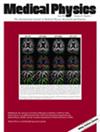Optimization of Low-Contrast Detectability in Abdominal Imaging: A Comparative Analysis of PCCT, DECT, and SECT Systems
Abstract
Background
Clear representation of anatomy is essential in the assessment of pathology in computed tomography (CT). With the introduction of photon-counting CT (PCCT) and more advanced iterative reconstruction (IR) algorithms into clinical practice, there is potential to improve low-contrast detectability in CT protocols. As such, it is necessary to perform task-based assessments to optimize protocols and compare image quality between PCCT and energy-integrating CT, like dual-energy CT (DECT) and single-energy CT (SECT).
Purpose
This work aimed to assess low-contrast detectability in abdominal protocols used in clinical PCCT, DECT, and SECT, using both model and human observers.
Methods
Data were acquired with the standard resolution scan mode on a PCCT (NAEOTOM Alpha, Siemens Healthineers, Forchheim, Germany) and a DECT/SECT (SOMATOM Force, Siemens Healthineers, Forchheim, Germany). Detectability was investigated in the CTP 515 low-contrast module of the Catphan 600 phantom, which was surrounded by a fat annulus to simulate an abdomen and resulted in a water equivalent diameter of 298 mm. Supra-slice contrast rods with a nominal 1.0% contrast and diameters of 4, 6, 9, and 15 mm were used. Factory abdominal protocols were adjusted to acquire images with various tube potentials (70, 90, 120, and 140 kV in PCCT; 70/150Sn and 80/150Sn kV in DECT; 100 and 120 kV in SECT), virtual monoenergetic image (VMI) energy levels (40 to 140 keV in PCCT and DECT), doses (5, 10 mGy in PCCT; 10 mGy in DECT and SECT), and IR settings (Br40 kernel, no quantum IR (QIR) and QIR levels 1 to 4 in PCCT; advanced modeled IR (ADMIRE) level 3 in DECT and SECT). Mixed DECT (linear blending of the images at two tube voltages) images were also reconstructed. The noise power spectrum and task transfer function of each scan protocol were quantified; the detectability index for each protocol was also determined using in-house implementations of model observers (non-prewhitening matched filters with internal noise, NPWI, and with an eye filter and internal noise, NPWEI) and human observers (in-house four-alternative forced choice, scoring with 95% confidence intervals).
Results
Results show that the image noise is minimized at a VMI energy corresponding to the applied spectrum's mean energy in PCCT and with VMI settings of 70 and 80 keV for 70/150Sn and 80/150Sn tube potential pairs, respectively, in DECT. With respect to the human observer detectability index calculations, the normalized root-mean-square error for the NPWI and NPWEI model observers was 5% and 12%, respectively. PCCT VMI improves low-contrast detectability. Additionally, detectability can be matched between PCCT protocols by increasing the QIR strength level when reducing the dose. Not only does PCCT VMI outperform DECT VMI, but also DECT VMI outperforms DECT mixed imaging in improving low-contrast detectability.
Conclusions
Low-contrast detectability is optimized when the appropriate VMI energy level is selected in PCCT and DECT to minimize image noise. PCCT improves low-contrast detectability and may allow for dose reduction in abdominal protocols compared to both DECT and SECT. The non-prewhitening model observer with internal noise better quantified low-contrast detectability without the inclusion of an eye filter.


 求助内容:
求助内容: 应助结果提醒方式:
应助结果提醒方式:


